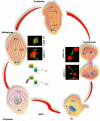Fez1/Lzts1 a new mitotic regulator implicated in cancer development
- PMID: 17718912
- PMCID: PMC2075490
- DOI: 10.1186/1747-1028-2-24
Fez1/Lzts1 a new mitotic regulator implicated in cancer development
Abstract
Considerable evidence has accumulated suggesting that cancer has genetic origin, based on the development of genomic alterations, such as deletions, mutations, and/or methylations in critical genes for homeostasis of cellular functions, including cell survival, DNA replication and cell cycle control. Mechanism controlling the precise timing and sequence of cell cycle events as well as checkpoints insuring fidelity of those events are key targets that when disrupted could result in tumorigenesis. Mitosis is the process by which a cell duplicates its genetic information (DNA), in order to generate two, identical, daughter cells. In addition each daughter cell must receive one centrosome and the appropriate complements of cytoplasm and organelles. This process is conventionally divided in to five distinct stages: prophase, prometaphase, metaphase, anaphase and telophase that correspond to a different morphology of the cell. The entry into mitosis (M) is under the control of the cyclin dependent kinase Cdk1. During G2, the kinases Wee1 and Myt1 phosphorylate Cdk1 at T14/Y15 residues, rendering it inactive. The transition from G2 to M is promoted by the activation of Cdk1 via dephosphorylation by the Cdk1 phosphatase Cdc25C. Activated Cdk1 complexes translocate into the nucleus during prophase where phosphorylate numerous substrates in order to enhance their activation as the cells progresses trough prophase, prometaphase, and metaphase.Recently we identified a new player: FEZ1/LZTS1 that contributes to the fine-tuning of the molecular events that determine progression through mitosis, and here will review its role in cancer development and in M phase regulation.
Figures


Similar articles
-
Take your "M" time.Cell Cycle. 2007 Sep 1;6(17):2087-90. doi: 10.4161/cc.6.17.4628. Epub 2007 Jun 21. Cell Cycle. 2007. PMID: 17873519
-
Cyclin B1-Cdk1 activation continues after centrosome separation to control mitotic progression.PLoS Biol. 2007 May;5(5):e123. doi: 10.1371/journal.pbio.0050123. PLoS Biol. 2007. PMID: 17472438 Free PMC article.
-
Fez1/Lzts1 absence impairs Cdk1/Cdc25C interaction during mitosis and predisposes mice to cancer development.Cancer Cell. 2007 Mar;11(3):275-89. doi: 10.1016/j.ccr.2007.01.014. Cancer Cell. 2007. PMID: 17349584 Free PMC article.
-
CDC6 as a Key Inhibitory Regulator of CDK1 Activation Dynamics and the Timing of Mitotic Entry and Progression.Biology (Basel). 2023 Jun 14;12(6):855. doi: 10.3390/biology12060855. Biology (Basel). 2023. PMID: 37372141 Free PMC article. Review.
-
The role of CDC25C in cell cycle regulation and clinical cancer therapy: a systematic review.Cancer Cell Int. 2020 Jun 3;20:213. doi: 10.1186/s12935-020-01304-w. eCollection 2020. Cancer Cell Int. 2020. PMID: 32518522 Free PMC article. Review.
Cited by
-
A signature-based method for indexing cell cycle phase distribution from microarray profiles.BMC Genomics. 2009 Mar 30;10:137. doi: 10.1186/1471-2164-10-137. BMC Genomics. 2009. PMID: 19331659 Free PMC article.
-
MicroRNA-135b Regulates Leucine Zipper Tumor Suppressor 1 in Cutaneous Squamous Cell Carcinoma.PLoS One. 2015 May 4;10(5):e0125412. doi: 10.1371/journal.pone.0125412. eCollection 2015. PLoS One. 2015. PMID: 25938461 Free PMC article.
-
ESOMIR: a curated database of biomarker genes and miRNAs associated with esophageal cancer.Database (Oxford). 2023 Oct 10;2023:baad063. doi: 10.1093/database/baad063. Database (Oxford). 2023. PMID: 37815872 Free PMC article.
-
Clinical and histopathological features and immunoreactivity of human choroidal and ciliary melanomas as prognostic factors for metastasis and death.Graefes Arch Clin Exp Ophthalmol. 2011 Dec;249(12):1795-803. doi: 10.1007/s00417-011-1769-7. Epub 2011 Aug 17. Graefes Arch Clin Exp Ophthalmol. 2011. PMID: 21847577
-
Delineating the HMGB1 and HMGB2 interactome in prostate and ovary epithelial cells and its relationship with cancer.Oncotarget. 2018 Apr 10;9(27):19050-19064. doi: 10.18632/oncotarget.24887. eCollection 2018 Apr 10. Oncotarget. 2018. PMID: 29721183 Free PMC article.
References
-
- Ishii H, Baffa R, Numata S, Murakumo Y, Rattan S, Inoue H, Mori M, Fidanza V, Alder H, Croce CM. The FEZ1 gene at chromosome 8p22 encodes a leucine-zipper protein, and its expression is altered in multiple human tumors. Proc Natl Acad Sci USA. 1999;96:3928–3933. doi: 10.1073/pnas.96.7.3928. - DOI - PMC - PubMed
-
- Teufel A, Weinmann A, Galle PR, Lohse AW. In silico characterization of LZTS3, a potential tumor suppressor. Oncol Rep. 2005;14:547–551. - PubMed
-
- Vecchione A, Ishii H, Shiao YH, Trapasso F, Rugge M, Alder H, Croce CM, Baffa R. Altered expression of Fez1 protein in gastric carcinoma. Clin Cancer Res. 2001;7:1546–1552. - PubMed
LinkOut - more resources
Full Text Sources
Molecular Biology Databases
Research Materials
Miscellaneous

